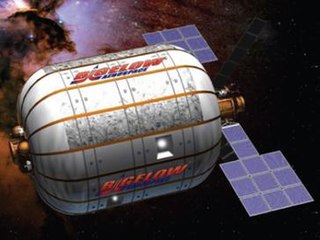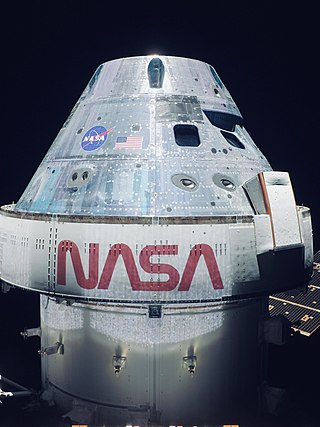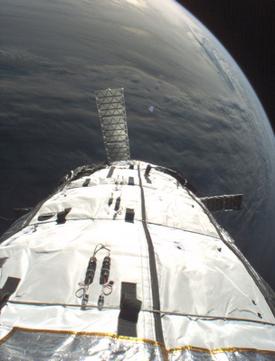
TransHab was a program pursued by NASA in the late 1990s to develop the technology for expandable habitats inflated by air in space. TransHab was intended as a replacement for the existing rigid International Space Station crew Habitation Module. When deflated, inflatable modules provide an 'easier to launch' compact form. When fully inflated, TransHab would expand to 8.2 metres (27 ft) in diameter.
Bigelow Aerospace was an American space design and manufacturing company which closed its doors in 2020. It was an aeronautics and outer space technology company which manufactured and developed expandable space station modules. Bigelow Aerospace was founded by Robert Bigelow in 1998, and was based in North Las Vegas, Nevada. It was funded in large part by the profit Bigelow gained through his ownership of the hotel chain, Budget Suites of America.

Robert Thomas Bigelow is an American businessman. He owns Budget Suites of America and is the founder of Bigelow Aerospace.

The B330 was an inflatable space habitat privately developed by Bigelow Aerospace from 2010 until 2020. The design was evolved from NASA's TransHab habitat concept. B330 was to have 330 cubic meters (12,000 cu ft) of internal volume, hence its numeric designation.

The Space Station Processing Facility (SSPF) is a three-story industrial building at Kennedy Space Center for the manufacture and processing of flight hardware, modules, structural components and solar arrays of the International Space Station, and future space stations and commercial spacecraft. It was built in 1992 at the space complex's industrial area, just east of the Operations and Checkout Building.

Genesis II is the second experimental space habitat designed and built by the private American firm Bigelow Aerospace, launched in 2007. As the second module sent into orbit by the company, this spacecraft built on the data and experience gleaned from its previously orbited sister-ship Genesis I. Like its sister-ship and other modules being designed by Bigelow Aerospace, this spacecraft was based on the NASA TransHab design, which provided increased interior volume and reduced launch diameter along with potentially reduced mass compared to traditional rigid structures.

Galaxy was a canceled prototype space habitat designed by the American firm Bigelow Aerospace, and was intended to be the third spacecraft launched by the company in their efforts to create a commercial space station. Like other modules made by Bigelow Aerospace, Galaxy was based on the inflatable TransHab design by NASA, and was to be used for advanced systems testing before the company launched human-rated vehicles.

Sundancer was the proposed third prototype space habitat intended to be launched by Bigelow Aerospace—and the first human-rated expandable module based on TransHab technology acquired from NASA. It was to have been used to test and confirm systems used in the company's commercial space station efforts during the early 2010s, and if successful, would have formed the first piece of the proposed commercial space station.

Inflatable habitats or expandable habitats are pressurized tent-like structures capable of supporting life in outer space whose internal volume increases after launch. They have frequently been proposed for use in space applications to provide a greater volume of living space for a given mass.

The process of assembling the International Space Station (ISS) has been under way since the 1990s. Zarya, the first ISS module, was launched by a Proton rocket on 20 November 1998. The STS-88 Space Shuttle mission followed two weeks after Zarya was launched, bringing Unity, the first of three node modules, and connecting it to Zarya. This bare 2-module core of the ISS remained uncrewed for the next one and a half years, until in July 2000 the Russian module Zvezda was launched by a Proton rocket, allowing a maximum crew of three astronauts or cosmonauts to be on the ISS permanently.

Space architecture is the theory and practice of designing and building inhabited environments in outer space. This mission statement for space architecture was developed at the World Space Congress in Houston in 2002 by members of the Technical Aerospace Architecture Subcommittee of the American Institute of Aeronautics and Astronautics (AIAA). The architectural approach to spacecraft design addresses the total built environment. It is mainly based on the field of engineering, but also involves diverse disciplines such as physiology, psychology, and sociology.

The US Orbital Segment (USOS) is the name given to the components of the International Space Station (ISS) constructed and operated by the United States National Aeronautics and Space Administration (NASA), European Space Agency (ESA), Canadian Space Agency (CSA) and Japan Aerospace Exploration Agency (JAXA). The segment consists of eleven pressurized components and various external elements, almost all of which were delivered by the Space Shuttle.
The Bigelow Next-Generation Commercial Space Station was a private orbital space station under conceptual development by Bigelow Aerospace in the 2000s and 2010s. Previous concepts of the space station had included multiple modules such as two B330 expandable spacecraft modules as well as a central docking node, propulsion, solar arrays, and attached crew capsules. However it was also suggested that each B330 can operate as an independent space station. Attaching a B330 to the International Space Station or flying a B330 alone have been suggested by Robert Bigelow.

Orion is a partially reusable crewed spacecraft used in NASA's Artemis program. The spacecraft consists of a Crew Module (CM) space capsule designed by Lockheed Martin and the European Service Module (ESM) manufactured by Airbus Defence and Space. Capable of supporting a crew of four beyond low Earth orbit, Orion can last up to 21 days undocked and up to six months docked. It is equipped with solar panels, an automated docking system, and glass cockpit interfaces modeled after those used in the Boeing 787 Dreamliner. A single AJ10 engine provides the spacecraft's primary propulsion, while eight R-4D-11 engines, and six pods of custom reaction control system engines developed by Airbus, provide the spacecraft's secondary propulsion. Orion is intended to launch atop a Space Launch System (SLS) rocket, with a tower launch escape system.

The Bigelow Expandable Activity Module (BEAM) is an experimental expandable space station module developed by Bigelow Aerospace, under contract to NASA, for testing as a temporary module on the International Space Station (ISS) from 2016 to at most 2028, when the contract can not be extended any further. It arrived at the ISS on 10 April 2016, was berthed to the station on 16 April 2016, and was expanded and pressurized on 28 May 2016. Although originally planned to be a two year test, it has exceeded expectations and is used as additional cargo storage. The module is under ownership of NASA after Bigelow Aerospace suspended operations in 2021.

The project to create the International Space Station required the utilization and/or construction of new and existing manufacturing facilities around the world, mostly in the United States and Europe. The agencies overseeing the manufacturing involved NASA, Roscosmos, the European Space Agency, JAXA, and the Canadian Space Agency. Hundreds of contractors working for the five space agencies were assigned the task of fabricating the modules, trusses, experiments and other hardware elements for the station.

Axiom Orbital Segment or Axiom Segment are the planned modular components of the International Space Station (ISS) designed by Axiom Space for commercial space activities. Axiom Space gained initial NASA approval for the venture in January 2020. Axiom Space was later awarded the contract by NASA on February 28, 2020. This orbital station will be separated from the ISS to become a modular space station, Axiom Station, after the ISS is decommissioned.
Orbital Reef is an under development low Earth orbit (LEO) space station being designed by Blue Origin and Sierra Nevada Corporation's Sierra Space for commercial space activities and space tourism uses. Blue Origin has referred to it as a "mixed-use business park". The companies released preliminary concepts for the station on 25 October 2021. The station is being designed to support 10 persons in 830 m3 of volume. As of March 2022, the station was projected to be operational by 2027.

















